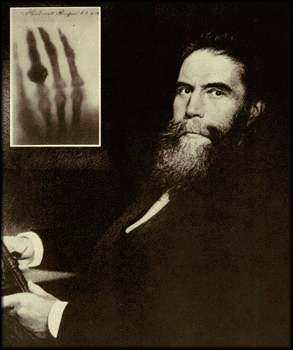

![]()

![]()

![]()

![]()

![]()

(The First Radiation Safety Officer?)
Department of Transportation | |
Environmental Protection Agency | |
Food and Drug Administration | |
Nuclear Regulatory Commission | |
Department of Energy | |
State Departments of Health | |
National Council of Radiation Protection and Measurements | |
International Council of Radiation Protection |

| November 8 - Discovery of X Rays ----- W. K. Roentgen |
January 3 - X-Ray report made public
| February - Discovery of Radioactivity -----H. Becquerel
| March 3 - First reports of possible x-ray injury; damage to eyes -----T. A..
Edison, W. J. Morton
| March 14 - Concern expressed over possibility of x-ray injury -----F.
Battelli
| April 10 - Epilation noted from x-ray exposure -----J. Daniel
| April 18 - Skin effects first noted -----L. G. Stevens
| July - First x-ray protective device: a heavy glass plate to protect the
eyes during dental radiography -----W. H. Rollins
| Reports of accidental injury (burns) -----H. D. Hawks
| November 18 - Deliberately induced experimental injury (burns) -----E.
Thomson
| Gold leaf electroscope used to make ionization measurements -----L.
Benoist | |
| Air thermometer used to measure energy transfer by x-rays -----E. Dorn |
January - Aluminum filter used as protective device -----E. Thomson
| May - Dark adaptation prior to fluoroscopy suggested -----F. H. Williams
| July - Leaded x-ray tub housing; collimators -----W. H. Rollins
| July - Word "radioactivity" coined -----P. & M. Curie
| December - Radium discovered -----P. & M. Curie
| Gamma rays discovered -----P. Villard | |
April - Radiographer licensure recommended to protect public -----J.
Dennis
| May - Malpractice award for x-ray burns
| Ozone hazard of x-ray generators noted
| Listing of protective devices (gloves, aprons, etc.) in x-ray catalog
-----R. Friedlander Co. | |
| Increased target to skin distance to reduce skin dose -----M. K. Kassabian |
January 3 - X-ray lethality to person alleged
| Skin burn caused by radium carried on person -----H. Becquerel
| X-ray lethality to mammals demonstrated experimentally -----W.
H.
Rollins | |
| X-ray lethality to mammalian fetus demonstrated -----W. H. Rollins |
Fractionation of exposure in fluoroscopy -----W. H. Rollins
| Protection committee within ARRS proposed -----S. H. Monell
| First direct reading radiation instrument; spinthariscope -----W.
Crookes | |
| October - First death in x-ray pioneer attributed to cumulative overexposure -----C. M. Dally |
| Radiation unit based on ionization first proposed -----M. Franklin |
| Law of radiosensitivity of tissues put forth -----J. Bergonie & R. Tribondeau |
Mutation by x-ray reported in toads -----C.R. Bardeen
| Photographic plate carried in pocket for monitoring x-ray exposure -----R.
V.
Wagner
| Use of gas-filled tubes for detection of radiation -----E. Rutherford | |
| International radium standard and Curie unit -----M. Curie |
| Half value layer concept -----T. Christan |
| Hot cathode x-ray tubes and tungsten targets permitting higher voltages -----W. D. Coolidge |
| British Roentgen Society adopts radiation protection recommendations |
| First standing x-ray protection committee -----ARRS |
| British X-Ray and Radium Protection Committee issues first memorandum |
American Roentgen Ray Society adopts radiation protection rules
| Film badges for personnel monitoring -----G. Pfahler | |
| First "tolerance dose" proposed -----A. Mutscheller |
Genetic effects of x-rays shown -----H.J. Muller
| First commercial U.S. ionization chamber -----J. Victoreen | |
Roentgen unit formally adopted
| International X-Ray and Radium Protection Committee formed (forerunner of
ICRP) | |
U.S. Advisory committee on X-Ray and Radium Protection formed (forerunner
of NCRP)
| First portable survey meter -----L. S. Taylor | |
| USACXRP publishes first recommendations - 0.2 R/day |
Concept of greater permissible dose for partial body irradiation (hands)
introduced -----G. Failla
| Discover of the neutron -----E. Chadwick | |
ICXRP recommends permissible dose of 0.2 R/day
| 0.1 R/day (0.5 R/wk) | |
| Statement of the Bragg-Gray principle of cavity ionization -----L. H. Gray |
| USACXRP recommends reduction in permissible dose to 0.1 R/day |
USACXRP recommends adoption of maximum body burden of 0.1 microCi for
radium
| Suggested maximum permissible dose of 0.02 R/day ----- L. S. Taylor | |
| Manhattan District- the term "health physics" is coined |
| 4 R/wk shown to cause injury ----- H. M. Parker |
Maximum permissible concentration for inhaled radioactivity
introduced
----- H. M. Parker
| Rem and rep introduced ----- H. M. Parker | |
| 0.3 R/wk |
| 0.3 rem/wk |
![]()
![]()
![]()